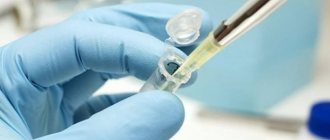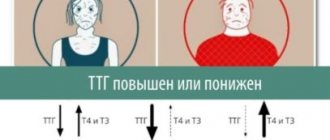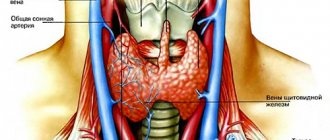The thyroid gland (TG) is a small organ, but extremely important for the harmonious functioning of all organs and systems. It is located on the anterior surface of the neck, in front of the thyroid cartilage of the larynx. The organ has two lobes connected by an isthmus. The thyroid gland produces the hormones thyroxine and triiodothyronine, which control reproductive function, redox reactions of the body, and the activity of the nervous and cardiovascular systems.
Enlargement of the thyroid gland occurs due to the uniform proliferation of its own cells (diffuse goiter). Uneven hyperplasia of thyroid tissue leads to nodulation (compaction in the parenchyma) - nodular goiter. The most common type of growth is the mixed form (diffuse nodular goiter).
Causes
Hyperplasia of the thyroid gland usually occurs for one of the following reasons:
- iodine deficiency. Occurs when there is a lack of iodine in the daily diet. In this case, diffuse (endemic) hyperplasia develops;
- taking medications. Certain groups of drugs (sulfonamides, resorcinol, anti-tuberculosis drugs) inhibit the production of the hormones thyroxine and triiodothyronine;
- chronic bacterial infection. Stimulates the growth of compactions (nodes) in the thickness of the gland. The condition is observed with tonsillitis, sinusitis;
- vitamin D deficiency;
- frequent stress or increased physical activity;
- brain tumors (hypothalamus and pituitary gland) regulate the functioning of the thyroid gland and other endocrine glands. The pituitary gland produces thyroid-stimulating hormone (TSH), which directly affects the synthesis of thyroid hormones;
- burdened heredity. A predisposition to the occurrence of autoimmune processes is transmitted from parents to children.
Symptoms of hyperplasia
The manifestation of hyperplasia depends on the degree and type of disruption of the gland. Some disorders do not make themselves manifest clinically; only a deformation of the neck may indicate an ongoing pathology. In the initial stages of development, many diseases are also asymptomatic. If they are not treated promptly, the gland enlarges so much that difficulty breathing and swallowing occurs.
Pronounced hyperplasia
Pronounced symptoms usually appear in elderly patients with untimely treatment of the disease. Here they are:
- difficulties with swallowing due to compression of the esophagus by a hypertrophied gland, which makes it difficult for the patient to swallow even a pill on his own;
- breathing difficulties that occur while lying down or during physical activity due to the pressure of the hypertrophied gland on the trachea. Patients feel short of breath;
- The timbre of the voice changes due to compression of the nerve innervating the vocal cords. Usually the voice becomes lower and sometimes becomes hoarse. The symptom is most pronounced in speakers;
- cough;
- the appearance of circulatory disorders due to compression of blood vessels. There is redness of the neck and face;
- pain associated with bleeding due to injury to blood vessels
With nodular hyperplasia of the thyroid gland, a number of other symptoms appear: insomnia, body weight problems, hypertension, arrhythmia, increased panic, irritability, depression.
It is necessary to determine hyperplasia of the thyroid gland in children taking into account the characteristics of the child’s growth rate, his age, relationships with peers, and the dynamics of school performance.
The level of thyrotropin, normal for this age, but high for an adult, can cause misunderstandings in the relationship between “fathers” and “children”.
Hypothyroidism in an adult does not mean a similar syndrome in a child. In any case, you will need to consult an endocrinologist.
Symptoms
Each form of the disease has its own symptoms. The following features are considered common:
- weight loss or gain for no apparent reason;
- frequent mood swings, irritability, outbursts of anger;
- increased fatigue, constant weakness;
- sleep disorder;
- increased sweating;
- hair loss;
- cardiovascular problems: arrhythmias, shortness of breath, chest discomfort;
- menstrual irregularities in women and problems with potency in men;
- sensation of a lump in the throat when swallowing (with significant enlargement of the organ).
With hypothyroidism, the following are added: swelling, loss of appetite, dry skin, decreased blood pressure, and a tendency to constipation.
Accelerated metabolic processes are manifested by typical symptoms: osteoporosis, hand tremors, exophthalmos (protrusion of the eyes), brittle nails and hair, increased physical activity, and attacks of aggression. The thyroid nodules can become inflamed, manifested by pain, high fever, and an increase in the size of the organ.
Discussion
Currently, the dominant theory of pituitary origin is that the vast majority of pituitary adenomas arise as a result of gene disorders in a single cell.
Subsequently, its tumor transformation occurs, followed by clonal expansion and adenoma formation. Most TSH-AGs are plurihormonal tumors that originate from pituitary stem cells and have the potential to differentiate in various directions. In 30-40% of cases, TSH-AH is characterized by hypersecretion of other pituitary hormones - most often GH and PRL, less often - gonadotropins (LH/FSH). Even in the case of hypersecretion of only TSH, in most TSH-AGs, genetic analysis reveals the expression of the GH and PRL genes [17, 18]. Hypersecretion of TSH by tumor tissue leads to hyperstimulation of the thyroid gland and, as a consequence, hypersecretion of thyroid hormone. T4 and St. T3 [11]. This is the so-called “central hyperthyroidism”. Clinically, it is manifested by symptoms of hyperthyroidism, and with a significant tumor size, also by signs of tumor mass effect: visual and neurological disorders. Violation of hypothalamic regulation is also an important link in the oncogenesis of the adenohypophysis. Thus, chronic hypofunction of the peripheral endocrine glands induces constant hypothalamic stimulation with subsequent hyperplasia and the formation of a pituitary tumor [9, 13, 19-22]. It is well known that with manifest PG the concentration of TSH in the blood is increased, and st. T4 is reduced. In such patients who do not receive thyroid hormone therapy for a long time, hyperplasia of thyroid-trophic cells may develop as a result of the lack of the inhibitory effect of these hormones on the hypothalamus. This in turn leads to an increase in the production of TRH (thyrotropin-releasing hormone), which stimulates the pituitary gland, which is manifested by the development of hyperplasia of thyrotrophic cells. Cases of compression of the optic nerves by the hyperplastic pituitary gland and the appearance of neuro-ophthalmological symptoms have been described [cit. according to 7].
Increased secretion of TRH by the hypothalamus can lead not only to hyperplasia of thyrotrophic cells and increased secretion of TSH, but also to hyperplasia of lactotrophic cells and increased synthesis and secretion of PRL, which is accompanied by an increase in the level of PRL in the blood and clinical manifestations of hyperprolactinemia [23]. Hyperplasia of thyroid cells as a result of PG is most common in women and is usually reversible with the use of adequate doses of thyroid hormones, which is manifested by normalization of TSH levels, st. T4 and St. T3 and also PRL.
However, long-term stimulation of TRH can lead to the formation of so-called “secondary” TSH-AG [10]. In a study by N. Ryan [9] of autopsy material from 64 pituitary glands from patients with chronic hypothyroidism, thyrotrophic hyperplasia was found in most cases. Diffuse hyperplasia of thyrotrophic cells was detected in 69% of samples, and nodular hyperplasia of thyrotrophic cells was detected in 25%. In 12% of cases, the changes were regarded as an intermediate stage between nodular hyperplasia and microadenoma. Five pituitary microadenomas with positive TSH expression were identified. Lactotrophic hyperplasia was present in 20% of samples.
Differential diagnosis (including MRI signs) of adenohypophysis hyperplasia and true hypertension against the background of PG is often difficult, and as a result, difficulties arise in choosing a treatment method, which is fundamentally different for these types of pathologies. Thus, for thyrotrophic hyperplasia against the background of PG, an effective treatment method is therapy with L-T4 drugs, which leads to normalization of the level of thyroid hormones and, as a consequence, a decrease in the level of TSH and regression of thyrotrophic hyperplasia, which is manifested by a decrease in volume in the chiasmatic-sellar region. The duration from the start of treatment is usually 1-4 months, although in some cases regression of formation in the chiasmal-sellar region can be observed during the 1st week of L-T4 therapy [24, 25]. In patients with previous hyperprolactinemia, against the background of achieving euthyroidism, normalization of PRL levels and restoration of the menstrual cycle are observed. Therefore, it is not advisable to prescribe dopamine agonists until hypothyroidism is compensated. However, if L-T4 therapy leads to normalization of TSH and f. T4, and the PRL level remains high, with corresponding clinical symptoms of hyperprolactinemia and there is no reduction in the size of the adenoma, then the presence of prolactinoma is more likely [21]. If in a patient with PG, after 3-4 months of L-T4 therapy at an adequate dose, only a partial decrease in TSH levels is noted and no MRI signs of tumor regression are detected, then the possible development of autonomous production of TSH by the tumor—secondary thyrotropinoma—should be considered; however, therapy with L-T4 drugs is not effective in these cases. The choice of treatment for such patients is surgical adenomectomy followed by continuous L-T4 replacement therapy [20, 22].
We described four different clinical cases accompanied by an increase in the level of TSH in the blood: TSH-AG causing hyperthyroidism, TSH-AG in combination with PG (secondary thyrotropinoma), a combination of a hormonally inactive adenoma with primary hypothyroidism, as well as a case of reversible pituitary hyperplasia due to primary hypothyroidism.
In a patient with TSH-AH with clinical manifestations of hyperthyroidism, an IMG study confirmed the expression of TSH in the tumor, as well as GH and PRL. In the case of hypertension, accompanied by increased levels of TSH and St. T4, the diagnosis of thyrotropinoma usually leaves no doubt. It is advisable to study PRL, GH, IGF-1, and also, in some cases, measure the level of GH during an oral glucose tolerance test to exclude mixed hormonal secretion. The literature [26, 27] describes cases of successful treatment of TSH-AH with somatostatin analogues and dopamine agonists, but the most effective treatment method remains surgical (Fig. 5).
Rice. 5. Possible reasons for increased TSH levels in a patient with a large tumor of the pituitary gland and treatment algorithm.
In a patient with PG (clinical case 4), L-T4 therapy led to euthyroidism and regression of pituitary gland formation and was regarded as hyperplasia of thyrotrophic cells. In another observation (clinical case 2), despite a decrease in TSH levels, no significant tumor reduction was noted. It cannot be excluded that the secondary genesis of thyrotropinoma due to untreated P.G. It is quite possible that the tumor developed against the background of hyperplasia of thyrotrophic cells of the pituitary gland, as described in some studies [14, 20]. The patient underwent surgical treatment (IMG study confirmed the expression of TSH, STH and PRL in the tumor tissue).
Due to the high prevalence of PH in the population, there are frequent cases of detection of this disease in patients with hypertension, mainly hormonally inactive (which are more common in the older age group). We described a patient (case 3) with long-term untreated hypothyroidism who was operated on due to severe neuro-ophthalmological symptoms. Histological examination of the removed tumor revealed a combination of TSH-negative hypertension and thyrotrophic pituitary hyperplasia.
However, all patients with hypothyroidism require drug treatment to achieve euthyroidism during a control MRI study of the brain over time. The decision to operate can be made only in the absence of regression and clinical manifestations of tumor mass effect against the background of achieving euthyroidism.
The presented clinical cases substantiate the importance of considering various diagnoses in a patient with a pituitary tumor, accompanied by an increase in the level of TSH in the blood and identifying possible causes of such an increase.
No conflict of interest
.
Varieties and stages
Violation of the basic functions of the thyroid gland manifests itself in several clinical variants:
- Hypothyroidism
is an enlargement of the thyroid gland due to insufficient production of thyroid hormones. The primary process is the pathology of the gland itself. The cause may be Hashimoto's disease (an autoimmune disease), thyroid tumors. Secondary hypofunction is a consequence of changes in the pituitary gland and hypothalamus. - Euthyroidism
is an increase in organ volume without impaired secretion. The condition is observed during pregnancy, during the period of hormonal changes in the body (in adolescents or during menopause). - Hyperthyroidism
. Another name for the process is thyrotoxicosis. Hyperfunction of the gland is observed in inflammation of the thyroid gland, Graves' disease (goiter), and pituitary tumors.
Based on the latest classification, the severity of gland hypertrophy is of three types:
- Degree 0 – dimensions are normal.
- Degree 1 – a goiter is diagnosed only during examination, but is not visible with a normal neck position.
- Degree 2 – the goiter is visually noticeable and can be easily palpated.
Consequences
The most dangerous complication of hypothyroidism is hypothyroid coma. The survival rate when it occurs ranges from 10 to 40%. A comatose state (drowsiness, disorientation, decreased blood pressure) develops due to lack of proper treatment, injuries, and operations. Other negative consequences of thyroid hypofunction are problems with the cardiovascular system. The patient's heart rate slows down (bradycardia), hypertension and metabolic cardiomyopathy develop.
In a child with hypothyroidism, both physical and mental development are impaired: children with congenital pathology are lethargic, amicable, and suffer from edema. Neglected forms progress to dwarfism and cretinism.
Complications of hyperthyroidism are similar to hypothyroidism:
- heart rhythm disturbance - atrial fibrillation, which completely disappears with treatment;
- due to a lack of calcium, osteoporosis develops, bones become fragile;
- decreased visual acuity due to swelling of the tissues around the eyeballs;
- Graves' dermopathy - swelling and redness of the skin of the feet and legs;
- thyrotoxic crisis. Symptoms of hyperthyroidism intensify against the background of severe tachycardia, sweating and confusion. The condition requires urgent care;
- oncology. Enlarged lymph nodes in the presence of nodular hyperplasia of the thyroid gland may indicate a malignant process.
Signs of the disease
Signs of an enlarged thyroid gland in Tibetan medicine are manifestations of the “heat” or “cold” scenario.
The “heat” option is associated with disturbance of the Bile dosha: the nervous system and cardiovascular system are activated, and metabolism accelerates. Hyperfunction of the thyroid gland is accompanied by dysfunction of the liver and reproductive function.
Signs of hyperplasia according to the “cold” scenario are caused by the disturbed Mucus dosha. “Cold” inhibits all processes in the body, and symptoms of hypothyroidism develop. Metabolism slows down, manifested by drowsiness, swelling, deterioration of memory and mental abilities.
The decisive factor for the development of goiter is the disturbance of the Wind constitution, which is responsible for the emotional sphere. With frequent grievances, anxieties, and irritability, an emotional “lump” forms in the throat - a spasm from unexpressed emotions. The normal flow of blood in the thyroid gland is disrupted, which provokes the development of the disease.
Diagnostics
The growth of the thyroid gland with diffuse changes is determined after the examination plan:
- tests for thyroid hormones;
- Ultrasound of the organ to identify nodes;
- scintigraphy with contrast agent. Necessary for identifying “cold” nodes;
- CT and MRI. Expensive methods are indicated in exceptional cases - to clarify controversial issues;
- Biopsy of node tissue. Helps confirm or exclude oncology.
Tibetan traditional medicine carries out diagnostics without chemicals and without injections.
The Naran Clinic uses gentle and effective diagnostic methods:
- Survey. The doctor finds out the patient’s emotional background, asks about his relationships with family and friends, and his worldview. Questions like these are an opportunity to find out the patient’s predominant dosha.
- Inspection and palpation. The eastern healer palpates the front of the neck to determine the size of the thyroid gland. The condition of the patient’s skin, nails, color of the tongue and eyeballs is also carefully examined. All this will help not only in making a correct diagnosis, but also determine the root cause of deterioration in health.
- Pulse diagnostics. Detection of disorders in the body by pulse is an ancient and reliable method of oriental medicine. By the nature, amplitude and frequency of the pulse wave, the doctor determines the patient’s leading constitution and its indignant state.
Classification of gland hyperplasia
The dimensions of the thyroid gland are given by endocrinologists to 3 degrees of goiter:
- no goiter;
- hyperplasia is present, but not visually displayed;
- the size of the gland is increased up to a change in the shape of the neck.
Some endocrinologists still use the old classification system, which distinguishes six degrees of hyperplasia:
- zero degree, in which the thyroid gland cannot be palpated during palpation;
- the first degree, when the thyroid gland itself cannot be palpated, is noted only when swallowing hyperplasia of the isthmus of the thyroid gland;
- second degree - the entire thyroid gland can be felt when swallowing;
- third degree is characterized by mild neck deformity due to thyroid hyperplasia;
- fourth degree, in which severe deformation of the neck is observed;
- the last, fifth degree, when an overgrown goiter compresses neighboring organs and tissues due to its enormous size.
Treatment
Western doctors (allopaths) often begin treatment with medications - high doses of hormonal drugs. Lifelong replacement therapy does not leave the patient a chance for a full recovery. If thyroid nodules grow or become inflamed, surgical treatment is indicated. Therapy of a malignant process requires a course of chemotherapy and radiation in the required doses, selected by a specialist.
Tibetan medicine aims to identify the underlying cause. Eastern doctors do without pills and hormones in their treatment methods. They analyze each problem in detail, finding a solution even for autoimmune thyroiditis. Tibetan practice does not resort to surgical methods - treatment of advanced forms of diseases occurs without surgery.
Prices for Tibetan traditional medicine services depend on the complexity of the clinical case and the scope of diagnostic and therapeutic measures performed.
The main (but far from complete) list of therapeutic procedures performed for hyperplasia of thyroid tissue:
- Correction of nutrition and lifestyle. The daily diet is selected depending on the disturbed dosha. The “heat” scenario excludes spicy, fatty, fried foods, seasonings and sauces. The “cold” option is associated with the ban on flour and sweets. Tibetan doctors recommend enriching the diet with fiber (cabbage, apples, carrots), seaweed, onions, garlic, ginger in order to balance the functioning of the thyroid gland.
- Phytotherapy. Drugs are selected individually, pursuing one goal - stabilization of the disturbed constitution. The medicinal herbal collection includes the following components: ammonia, mumiyo, cinnamon, medicinal salts, costus, sophora, ginger, cumin, myrobalan, hebula - all of them help normalize the biochemical reactions of the body, strengthen the immune system, and eliminate inflammatory foci.
- Acupuncture - an ancient technique of inserting needles into bioactive points on the skin helps eliminate energy imbalances, relieves swelling and inflammation.
- Moxibustion therapy. The smoke of a wormwood cigar stabilizes energy meridians, fighting “heat” and “cold” diseases.
- Acupressure - finger pressure on bioactive points acts similar to acupuncture.
The comprehensive, multi-stage and professional approach of Tibetan healers to the disease will help to cope with thyroid problems once and for all.
Treatment of hyperplasia
The purpose of the treatment regimen is selected after a detailed diagnosis and clarification of the cause of the disease. What distinguishes thyroid hyperplasia from other diseases? First of all, treatment using conservative methods, without the use of surgical intervention. For small or medium enlargements of the thyroid gland, hormonal medications in the form of tablets are prescribed.
Treatment with hormones for gland hypertrophy compensates for the lack of hormones in the body. If it is possible to restore the normal natural production of thyroid hormones, then the growth of the gland stops and gradually the volume of the gland returns to normal. If it is impossible to achieve the desired effect with replacement therapy, the thyroid gland is removed surgically.
The thyroid gland is also surgically removed in case of significant enlargement, when it begins to compress the trachea and esophagus and causes difficulty breathing and swallowing. If X-rays and computed tomography of the neck show such compression of organs, there is no doubt about surgical intervention.
The next reason for surgical removal of the thyroid gland is malignant neoplasms. One in twenty thyroid tumors is malignant.
Although there is no indication for surgery for a cosmetic defect, some patients still require thyroidectomy to eliminate the visible effect of hyperplasia.
Adenomatous hyperplasia of the thyroid gland
Sometimes an isotope of radioactive iodine is used as treatment, which makes it possible to monitor growth processes in the thyroid gland. This method allows you to reduce the volume of the gland. A prerequisite after the administration of radioactive iodine is the use of synthetic drugs containing thyroid hormones.
When the size of the gland can be reduced without the use of hormonal therapy and, especially, surgical intervention, they are limited to adjusting the diet to include seafood and iodine-containing foods.
Note that the treatment regimen for hyperplasia of the right lobe of the thyroid gland does not differ in the increase in the entire gland or another lobe.
Case from practice
A 50-year-old woman with diffuse enlargement of the thyroid gland came to the Naran clinic in Moscow. Olga Sergeevna complained of rapid heartbeat, sweating, difficulty swallowing, and poor sleep. According to an ultrasound examination, the volume of the thyroid gland was 36 cm³ (the norm is 18 cm³), according to the analysis, hormones were normal. From a conversation with the patient, it became clear that the development of the disease was influenced by severe stress. Olga Sergeevna is an emotional and excitable person. A doctor of Tibetan medicine diagnosed the woman with a constitutional disorder “Wind” and prescribed an appropriate set of treatment. The complex treatment included taking herbal remedies, acupressure, acupuncture, and moxotherapy. During the treatment, the woman’s well-being improved significantly - sleep was restored, sweating and rapid heartbeat disappeared, and the feeling of a lump in the throat went away. Three months after complex treatment, she was prescribed a second course of Tibetan herbal remedies. After two courses of treatment, control ultrasound showed that the volume of the thyroid gland decreased to 19 cm³. Olga Sergeevna was recommended a course of treatment after 6 months to consolidate the effect.
Questions
- Can the thyroid gland shrink after enlargement?
An increase in the size of the thyroid gland indicates the development of pathological processes in it. With adequate therapy, the size of the thyroid gland decreases. If any abnormalities are detected in the thyroid gland, consultation with a specialist is necessary. - Is an enlarged thyroid gland dangerous?
The thyroid gland plays a key role in the functioning of the entire body, as it produces vital hormones. An enlarged thyroid gland leads to the development of serious diseases, in severe cases it can be fatal. - How to recognize an enlarged thyroid gland?
An enlarged thyroid gland can be recognized by its characteristic symptoms, appearance, and diagnostic data (ultrasound of the thyroid gland, CT scan, MRI of the thyroid gland, tests for thyroid hormones). Doctors of Tibetan medicine can recognize signs of thyroid pathology at the stage of pulse diagnosis.
Bibliography
- Tibetan medicine: Big encyclopedia / Svetlana Choizhinimaeva. - Moscow: Eksmo, 2015. - 384 p. - (Russian Medical Library). ISBN 978-5-699-79532-1.
- “Choosing vitamins.” — Iozefovich O.V., Ruleva A.A., Kharit S.M. — Issues of modern pediatrics — 2010.
- Haglund MM, Moore AJ, Marsh H, Uttley D. Outcome after repeat lumbar microdiscectomy. // Br J Neurosurg. – 1995 – V. 9 – P.487–95.
- Delicious food. Tibetan medical science about the art of food / Svetlana Choizhinimaeva. — Moscow: Arguments of the Week, 2021. — 320 p. ISBN 978-5-9908777-0-2.
- Notes of a doctor of Tibetan medicine / Svetlana Choizhinimaeva. — Moscow: Arguments of the Week, 2021. — 160 p. — ISBN 978-5-6040607-2-8.
- McGirt MJ, Ambrossi GL, Datoo G, Sciubba DM et al. Recurrent disc herniation and long–term back pain after primary lumbar discectomy: review of outcomes reported for limited versus aggressive disc removal. // Neurosurgery. – 2009 – V.64 – P.338–45.
- "Physiological basis of nutrition." Zinchuk V.V. — Journal of Grodno State Medical University — 2014.










